Walt Disney Movie That Rob Thomas Did the Soundtrack for
- "I only hope that we never lose sight of one thing — that it was all started by a mouse."
- ―Walt Disney[src]
Walter Elias "Walt" Disney was an American entrepreneur, business magnate, animator, voice actor, producer, director, writer, and the eponymous founder of The Walt Disney Company. One of the most famous and well-known motion picture producers in the world, Walt co-founded his namesake company, Walt Disney Productions, with his brother, Roy in 1923.
Walt Disney is in particular noted for being a successful storyteller, a hands-on film producer, and a popular showman. He and his staff created a number of the world's most popular animated properties; including the one creation that many consider Disney's alter-ego, Mickey Mouse.
He was also the original voice of Mickey Mouse from 1928 to 1947 and again from 1955 and 1962. He also did the original voices of Minnie Mouse and Pete as well.
Contents
- 1 1901-1919: Childhood
- 2 1920-1936: Early years in animation
- 2.1 Kansas City animation studios
- 2.2 Alice Comedies: Contract and new California studio
- 2.3 Oswald the Lucky Rabbit
- 2.4 The Creation of Mickey Mouse
- 2.5 Disney's daughters
- 3 1937-1954: Animated feature films
- 3.1 Disney's Folly: Snow White and the Seven Dwarfs
- 3.2 Wartime troubles
- 3.3 A dark chapter
- 4 1955-1966: Theme Parks and Beyond
- 4.1 Carolwood Pacific Railroad
- 4.2 Planning Disneyland
- 4.3 Expanding into new areas
- 4.4 Early 1960s successes
- 4.5 Plans for Disney World and EPCOT
- 4.6 Death
- 4.7 Impact
- 5 1967-present: Legacy
- 5.1 The Epcot theme park
- 5.2 The Disney entertainment empire
- 5.3 Disney theme parks today
- 5.4 Disney animation today
- 5.5 CalArts
- 6 Roles
- 7 Gallery
- 8 Trivia
- 9 See also
- 10 External links
1901-1919: Childhood
Walt Disney was born on December 5, 1901, in Chicago, Illinois to Elias Disney and Flora Call. He was named after his father's close friend Walter Parr, the minister at St. Paul Congregational Church. In 1906, his family moved to a farm near Marceline, Missouri. The family sold the farm in 1909 and lived in a rented house until 1910 when they moved to Kansas City. Disney was nine years old at the time.
According to the Kansas City Public School District records, Disney began attending the Benton Grammar School in 1911, and graduated on June 8, 1917. During this time, Disney also enrolled in classes at the Chicago Art Institute. He left school at the age of sixteen and became a volunteer ambulance driver in The Red Cross during World War I after he changed his birth certificate to show his year of birth as 1900 in order to be able to enlist in The Red Cross. He set sail for France in November but when he came, the fighting was over. He stayed in France until 1919.
1920-1936: Early years in animation
Kansas City animation studios
Disney returned to the USA, moved to Kansas City and, with Ub Iwerks, formed a company called "Iwerks-Disney Commercial Artists" in January 1920. The company faltered and Disney and Iwerks soon gained employment at the Kansas City Film Ad Corporation, working on primitive animated advertisements for local movie houses.
In 1921, Disney started Laugh-O-grams, Inc., which produced short cartoons based on popular fairy tales and children's stories. Among his employees were Iwerks, Hugh Harman, Rudolf Ising, Carman Maxwell, and Friz Freleng. The shorts were popular in the local Kansas City area, but their costs exceeded their returns. After creating one last short, the live-action/animation Alice's Wonderland, the studio declared bankruptcy in July 1923. Two of Disney's brothers, Roy Oliver Disney and Raymond Arnold Disney, were employed as bank tellers in the First National Bank in downtown Kansas City during this time when Walt was developing his Laugh-O-grams, Inc. Studio. Roy later invited Walt to move to Hollywood, California, and Disney earned enough money for a one-way train ticket to California, leaving his staff behind, but taking the finished reel of Alice's Wonderland with him.
Alice Comedies: Contract and new California studio
Disney set up shop with his brother Roy, started the Disney Brothers Studio in their Uncle Robert's garage, and got a distribution deal with New York City states-rights distributors Margaret J. Winkler and her fiancé Charles Mintz (via Winkler Pictures). Virginia Davis, the live-action star of Alice's Wonderland, was sequestered from Kansas, as was Ub Iwerks. By 1926, the Disney Brothers Studio had its name changed to Walt Disney Studio; the name Walt Disney Productions would be adopted in 1929. One of the studio's employees, Lillian Bounds, became Walt Disney's wife; they married on July 13, 1925.
The Alice Comedies were reasonably successful and featured both Dawn O'Day and Margie Gay as Alice after Virginia Davis' parents pulled her out of the series because of a pay cut. Lois Hardwick also briefly assumed the role. By the time the series ended in 1927, the focus was more on the animated characters, in particular, a cat named Julius who recalled Felix the Cat, rather than the live-action Alice.
Oswald the Lucky Rabbit
In January 1927, Mintz told Disney to create a cartoon character they could sell to Universal Pictures - Universal wanted to re-enter the cartoon business and needed a character of its own. Disney had Iwerks design a rabbit character, and when Universal approved the design, their publicity department named it Oswald.
In January 1928, Iwerks warned Walt that several of the animators at his studio were signing contracts with Winkler Pictures. George Winkler, one of the Winkler heads, had been talking with the animators during pick-up runs of the Oswald the Lucky Rabbit cartoons. In the following month, Disney went to New York to negotiate a higher fee per short from Mintz. Mintz announced that not only did he want to reduce the fee he paid Disney per short, but that he had most of his main animators, including Harman, Ising, Maxwell, and Freleng under contract. Mintz' final deal was for Walt and Roy become his employees. Disney declined, and it resulted in his contract for the Oswald series to not be renewed. Disney, Iwerks, and the few non-defecting animators secretly began work on a new mouse character during the production of the last contracted Oswald cartoons.
The Creation of Mickey Mouse

Walt Disney and Mickey Mouse.
Christened by Lillian Disney, Mickey Mouse made his film debut in a short called Plane Crazy, which was, like all of Disney's previous works, a silent film. After failing to find distributor interest in Plane Crazy or its follow-up, The Gallopin' Gaucho, Disney created a Mickey cartoon with sound called Steamboat Willie. A businessman named Pat Powers provided Disney with both distribution and the Cinephone, a bootlegged sound-synchronization process. Steamboat Willie became a success, and Plane Crazy, The Galloping Gaucho, and all future Mickey cartoons were released with soundtracks. Disney himself provided the vocal effects for the earliest cartoons and performed as the voice of Mickey Mouse until 1947 and replaced by sound effects guy Jimmy MacDonald.
Joining the Mickey Mouse series in 1929 were a series of musical shorts called Silly Symphonies, which began with The Skeleton Dance. Although both series were successful, the Disney studio was not seeing its rightful share of profits from Pat Powers, and in 1930, Disney signed a new distribution deal with Sony/Columbia Pictures, leaving behind Powers and Ub Iwerks, who had been lured into an exclusive contract with Powers. After heading the only mildly successful Ub Iwerks Studio, Iwerks would return to Disney in 1940 and, in the studio's research and development department, pioneer a number of film processes and specialized animation technologies.
By 1932, Mickey Mouse became the most popular cartoon character on the screen, and many competing studios such as Van Beuren and Screen Gems created Mickey Mouse clones in hopes of cashing in on Disney's success. After moving from Sony/Columbia to MGM/United Artists in 1932, Walt began producing the Silly Symphonies in the new three-strip Technicolor process, making them the first commercial films presented in a true-color process. The first color Symphony was Flowers and Trees, which won the first Academy Award for Best Short Subject: Cartoons in 1932. The same year, Disney received a special Academy Award for the creation of Mickey Mouse, whose series was moved into color in 1935 and soon launched spin-off series for supporting characters such as Donald Duck, Goofy, and Pluto.
Disney's daughters
As Mickey's co-creator and producer, Disney was almost as famous as his mouse cartoon character but remained a largely private individual. His greatest hope was to give birth to a child — preferably a son — but he and Lillian tried with no luck. Lillian finally gave birth to a daughter, Diane Disney Miller, on December 18, 1933; and the couple would adopt a second, Sharon Mae Disney, who was born December 21, 1936. Walt loved both of his children.
1937-1954: Animated feature films
Disney's Folly: Snow White and the Seven Dwarfs
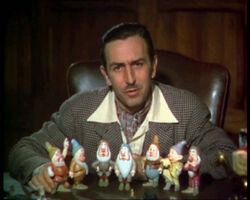
Walt Disney introduces each of the seven dwarfs.
Although his studio produced the two most successful cartoon series in the industry, the returns were still dissatisfying to Disney, and he began plans for a full-length feature in 1934. When the rest of the film industry learned of Disney's plans to produce an animated feature-length version of Snow White, they dubbed the project "Disney's Folly" and were certain that the project would destroy the Disney studio. Both Lillian and Roy tried to talk Disney out of the project, but he continued plans for the feature. He employed Chouinard Art Institute professor Don Graham to start a training operation for the studio staff, and used the Silly Symphonies as a platform for experiments in realistic human animation, distinctive character animation, special effects, and the use of specialized processes and apparatus such as the multiplane camera.
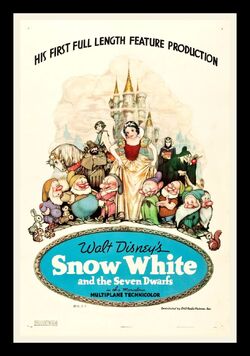
Walt Disney's Snow White and the Seven Dwarfs. This film was his studio's full-length feature production and the first commercially-successful animated feature film.
All of this development and training was used to elevate the quality of the studio so that it would be able to give the feature the quality Disney desired. Snow White and the Seven Dwarfs, as the feature was named, was in full production from 1935 until mid-1937, when the studio ran out of money. To acquire the funding to complete Snow White, Disney had to show a rough cut of the motion picture to loan officers at the Bank of America, who gave the studio the money to finish the picture. The finished film premiered at the Carthay Circle Theater on December 21, 1937; at the conclusion of the film the audience gave Snow White and the Seven Dwarfs a standing ovation. The first animated feature in English and Technicolor, Snow White was released in February 1938 under a new distribution deal with RKO Radio Pictures. The film became the most successful motion picture of 1938 and earned over $8 million (today $98 million) in its original theatrical release. The success of Snow White allowed Disney to build a new campus for the Walt Disney Studios in Burbank, which opened for business on December 24, 1939. The feature animation staff, having just completed Pinocchio, continued work on Fantasia and Bambi, while the shorts staff continued work on the Mickey Mouse, Donald Duck, Goofy, and Pluto cartoon series, ending the Silly Symphonies at this time.
Wartime troubles
Pinocchio and Fantasia followed Snow White into movie theaters in 1940, but both were financial disappointments. The inexpensive Dumbo was planned as an income generator, but during the production of the new film, most of the animation staff went on strike, permanently straining the relationship between Disney and his artists.
Shortly after Dumbo was released in October 1941 and became a successful moneymaker, the United States entered World War II. The U.S. Army took over most of the Disney studio's facilities and had the staff create training and instructional films for the military, as well as home-front propaganda such as Der Fuehrer's Face and the feature film Victory Through Air Power in 1943. The military films did not generate income, however, and Bambi underperformed when it was released in April 1942. Disney successfully re-issued Snow White in 1944, establishing the seven-year re-release tradition for Disney features.
Inexpensive package films, containing collections of cartoon shorts, were created and issued to theaters during this period as well. The most notable and successful of these were Saludos Amigos (1942), its sequel The Three Caballeros (1945), Song of the South (the first Disney feature to feature dramatic actors, 1946), Fun and Fancy Free (1947), and The Adventures of Ichabod and Mr. Toad (1949). The latter had only two sections: the first based on The Legend of Sleepy Hollow by Washington Irving and the second based on The Wind in the Willows by Kenneth Grahame.
By the late 1940s, the studio had recovered enough to continue production on the full-length features Alice in Wonderland and Peter Pan, which had been shelved during the war years and began work on Cinderella. The studio also began a series of live-action nature films, entitled True-Life Adventures, in 1948 with On Seal Island.
A dark chapter
In 1947, during the dark early years of the Cold War, Walt Disney testified before the House Un-American Activities Committee, and he named several of his employees as Communist sympathizers. Some historians believe that the animosity from the 1941 strike of Disney Studio employees caused him to bear a grudge. His dislike and distrust of labor unions may have also led to his testimony.
1955-1966: Theme Parks and Beyond
Carolwood Pacific Railroad
In 1949, when Disney and his family moved to a new home on large piece of property in the Holmby Hills district of Los Angeles, California, with the help of his friends Ward and Betty Kimball, owners of their own backyard railroad, Disney developed the blueprints and immediately set to work creating his own miniature railroad in his backyard. The name of the railroad, Carolwood Pacific Railroad, originated from the address of his home which was located on Carolwood Drive. The railroad's half-mile long layout included a 46-foot-long trestle, loops, overpasses, gradients, an elevated dirt berm, and a 90-foot tunnel underneath Mrs. Disney's flower bed. He even named the miniature working steam locomotive built by Roger E. Broggie of the Disney Studios Lilly Belle in his wife's honor.
Planning Disneyland
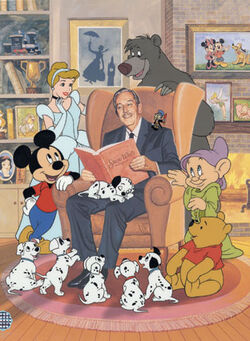
Walt and his Animated Family.
On a business trip to Chicago in the late 1940s, Disney drew sketches of his ideas for an amusement park where he envisioned his employees spending time with their children. These ideas developed into a concept for a larger enterprise which was to become Disneyland. Disney spent five years of his life developing Disneyland and created a new subsidiary of his company, called WED Enterprises, to carry out the planning and production of the park. A small group of Disney studio employees joined the Disneyland development project as engineers and planners and were dubbed Imagineers.
When presenting his plan to the Imagineers, Disney said: "I want Disneyland to be the most amazing place on Earth, and I want a train circling it". Entertaining his daughters and their friends in his backyard and taking them for rides on his Carolwood Pacific Railroad had inspired Disney to include a railroad in the plans for Disneyland.
Expanding into new areas
As Walt Disney Productions began work on Disneyland, it also began expanding its other entertainment operations. 1950's Treasure Island became the studio's first all-live-action feature, and was soon followed by such successes as 20,000 Leagues Under the Sea (in CinemaScope, 1954), The Shaggy Dog (1959), and The Parent Trap (1960). The Walt Disney Studio was one of the first to take full advantage of the then-new medium of television, producing its first TV special, One Hour in Wonderland, in 1950. Walt Disney began hosting a weekly anthology series on ABC named Disneyland after the park, where he showed clips of past Disney productions, gave tours of his studio, and familiarized the public with Disneyland as it was being constructed in Anaheim, California. In 1955, he debuted the studio's first daily television show, the popular Mickey Mouse Club, which would continue in many various incarnations into the 1990s.
As the studio expanded and diversified into other media, Disney devoted less of his attention to the animation department, entrusting most of its operations to his key animators, whom he dubbed the Nine Old Men. During Disney's lifetime, the animation department created the successful Lady and the Tramp (in CinemaScope, 1955) and One Hundred and One Dalmatians (1961) and the financially disappointing Sleeping Beauty (in Super Technirama 70 mm, 1959) and The Sword in the Stone (1963).
Production on the short cartoons had kept pace until 1956, when Disney shut down the shorts division. Special shorts projects would continue to be made for the rest of the studio's duration on an irregular basis.
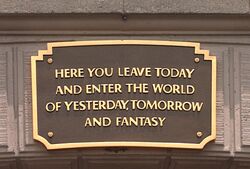
The Disneyland Plaque.
These productions were all distributed by Disney's new subsidiary Buena Vista Distribution, which had assumed all distribution duties for Disney films from RKO by 1955. Disneyland, one of the world's first theme parks, finally opened on July 17, 1955, and was immediately successful. Visitors from around the world came to visit Disneyland, which contained attractions based upon a number of successful Disney properties and films. After 1955, the Disneyland TV show became known as Walt Disney Presents, went from black-and-white to color in 1961—changing its name to Walt Disney's Wonderful World of Color—and eventually evolved into what is today known as The Wonderful World of Disney, which continues to air on ABC as of 2005.
During the mid-1950s, Disney produced a number of educational films on the space program in collaboration with NASA rocket designer Wernher von Braun: Man in Space and Man and the Moon in 1955, and Mars and Beyond in 1957. The films attracted the attention of not only the general public but also the Soviet space program.
Early 1960s successes
By the early 1960s, the Disney Empire was a major success, and Walt Disney Productions had established itself as the world's leading producer of family entertainment. After decades of trying, Disney finally procured the rights to P.L. Travers' books about a magical nanny. Mary Poppins, released in 1964, was the most successful Disney film of the 1960s, and many hailed the live-action/animation combination feature as his greatest achievement. The same year, Disney debuted a number of exhibits at the 1964 New York World's Fair, including Audio-Animatronic figures, all of which later were integrated into attractions at Disneyland and a new theme park project, to be established on the east coast, which Disney had been planning since Disneyland opened.
Plans for Disney World and EPCOT
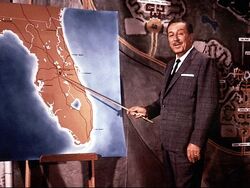
In 1964, Walt Disney Productions began quietly purchasing land in central Florida west of Orlando in a largely rural area of marginal orange groves for Disney's "Florida Project". The company acquired over 27,000 acres (109 square kilometers) of land and arranged favorable state legislation which would provide unprecedented quasi-governmental control over the area to be developed in 1966, founding the Reedy Creek Improvement District. Disney and his brother Roy then announced plans for what they called "Disney World". Disney World was to include a larger, more elaborate version of Disneyland to be called the Magic Kingdom, and would also feature a number of golf courses and resort hotels. The heart of Disney World, however, was to be the Experimental Prototype City (or Community) of Tomorrow, or EPCOT for short. EPCOT was designed to be an operational city where residents would live, work, and interact using advanced and experimental technology, while scientists would develop and test new technologies to improve human life and health.
Death
However, Disney's involvement in Disney World ended in late 1966, when he was diagnosed with lung cancer in his left lung, after a lifelong habit of chain-smoking (where his dreams of advancements in the improvement of human health would have come in handy) since World War 1. He was checked into the St. Joseph's Hospital across the street from the Disney Studio lot and his health eventually deteriorated. His dedication to his projects was still visible while lying in his deathbed. On the evening of December 14, Roy came to visit him. Here, Walt pointed up to the ceiling using the tiles as a grip map. He then signaled Roy about the roads and major places in EPCOT and Disney World. Even sick and near death, Walt's mind was clear, active, and vibrant; his imagination fully engaged and his voice enthusiastic.
It came as a complete shock to the Disney Family and to the whole world when Walt passed away the next morning. He was pronounced dead at 9:35 AM PST on December 15, 1966 having just celebrated his sixty-fifth birthday two weeks earlier. The official cause of death was "acute circulatory collapse." His heart simply stopped beating.
Contrary to urban legend, he was not cryogenically frozen. He was cremated and his ashes were interred in the Disney family garden in the Court of Freedom section of Forest Lawn Memorial Park in Glendale, California.
Impact
It was truly unthinkable. Walt Disney was dead. Roy, who had always been supportive to Walt, looking for and helping him, had lost his reason for living. After an hour or so, Walt's foot was sticking out from under the blanket. Roy was by the bed, gently rubbing Walt's foot and said "Well kid, it looks like the end of the road." Roy was still the older brother to the end.
Roy Disney carried out the Florida project, insisting that the name becomes Walt Disney World in honor of his brother. Roy O. Disney died only three months after that resort's opening in 1971.
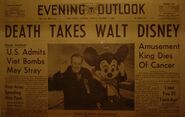
Walt Disney's Obituary
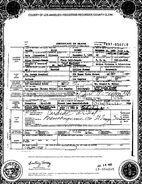
Walt Disney's Death Certificate
1967-present: Legacy
The Epcot theme park
When the second phase of the Walt Disney World theme park was built, EPCOT was translated by Walt Disney's successors into the Epcot theme park, which opened in 1982. The Epcot Park that currently exists is essentially a living world's fair, a far cry from the actual functional city that Disney had envisioned. However, the Celebration, Florida town built by the Walt Disney Company adjacent to Walt Disney World harkens back to the EPCOT vision that Walt would have wanted.
The Disney entertainment empire
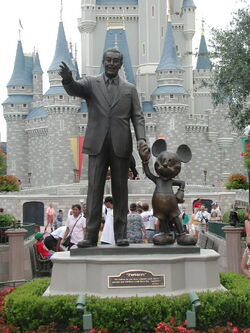
The famous "Partners" featuring Walt and Mickey at the Magic Kingdom park.
Today, Walt Disney's animation/motion picture studios and theme park have developed into a multi-billion dollar television, motion picture, vacation destination and media corporation that carries his name. The Walt Disney Company today owns, among other assets, four vacation resorts, nine theme parks, two water parks, thirty-two hotels (more on the way), eight motion picture studios, six record labels, eleven cable television networks, and one terrestrial television network.
Disney theme parks today
Today, what was known as the Florida Project is now the largest and most popular private-run tourist destination on the planet, but Walt Disney's spirit and shine is still there. From the 'Partners' statue at the Magic Kingdom to the Tree of Life at Animal Kingdom, Walt Disney is still remembered and loved by guests, Theme Park Characters and Cast Members alike, and his vision is still continued. His fascination with mass transportation lives in the Walt Disney World Monorail which runs through two theme parks and four hotels, and his dreams of the future live on at Epcot in ahead-of-their-time attractions and technological breakthroughs. His Skyway, long since closed, is now reborn as the Disney Skyliner gondola system.
Disneyland has developed from a cramped theme park to an open resort of two theme parks, three hotels, and a large shopping complex. Walt Disney World is a popular destination for vacations by tourists worldwide, and Tokyo Disneyland is the most visited theme park in the world (its sister park Tokyo Disneysea is the second). In September 2005, The Walt Disney Company opened Hong Kong Disneyland Resort in China, with another Chinese theme park followed—Shanghai Disneyland.
On May 5, 2005, the Walt Disney Company opened the Happiest Homecoming on Earth celebration in front of Walt's Sleeping Beauty Castle at Disneyland, celebrating fifty years of the world's most famous theme park. Walt Disney Parks and Resorts are renowned over the world for their attentions to detail, hygiene and standards, all set by Walt Disney at Disneyland.
Disney animation today
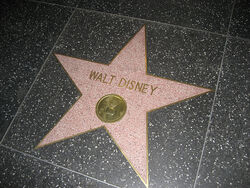
Traditional hand-drawn animation, with which Walt Disney started his company, was, for a time, no longer produced at the Walt Disney Animation Studios. After a stream of financially unsuccessful traditionally animated features in the early 2000s, the two satellite studios in Paris and Orlando were closed, and the main studio in Burbank was converted to a computer animation production facility. In 2004, Disney released what was announced as their final "traditionally animated" feature film, Home on the Range. However, since the 2006 acquisition of Pixar, and the resulting rise of John Lasseter to Chief Creative Officer, that position has changed, and the largely successful 2009 film The Princess and the Frog has marked Disney's return to traditional hand-drawn animation.
CalArts
Disney devoted substantial time in his later years funding The California Institute of the Arts (CalArts), which was formed in 1961 through a merger of the Los Angeles Conservatory of Music and the Chouinard Art Institute, which had helped in the training of the animation staff during the 1930s. When he died, one-fourth of his estate went towards CalArts, which greatly helped the building of its campus. Walt also donated 38 acres (154,000 m²) of the Golden Oaks ranch in Valencia for the school to be built on. CalArts moved onto the Valencia campus in 1971.
Lillian Disney devoted a lot of her time after Walt died to pursuing CalArts and organized hundreds of fundraising events for the university in her late husband's honor (as well as funding the Walt Disney Symphony Hall). After Lillian's passing, the legacy continued with daughter Diane and husband Ron continuing the tradition. CalArts is today one of the largest independent universities in California today, mostly because of the contributions of the Disneys.
Roles
Gallery

Trivia
- The 2007 film, Meet the Robinsons pays tribute to Walt Disney. The film ends with a quote from Walt Disney himself: "Around here, however, we don't look backwards for very long. We keep moving forward, opening up new doors and doing new things, because we're curious... and curiosity keeps leading us down new paths."
- The phrase "keep moving forward" is constantly used during the film, in reference to the Walt Disney quote.
- In the ABC television series Once Upon a Time, August Booth reveals to them that the fairy tale story book was created by a series of Authors, and names one past Author as "Walt". The implication that Disney himself is an Author is further proved in a flashback to 1966 when the Sorcerer's Apprentice approaches Isaac Heller and offers him the position of Author, citing that the previous Author had passed away; 1966 is the year the Disney passed away and his death date of December 15th was written on a letter from the Apprentice to Isaac.
- Disney had very simple tastes in food. According to his daughter Diane, "He liked fried potatoes, hamburgers, western omelets, hotcakes, canned peas, hash, stew, roast beef sandwiches. He doesn't go for vegetables, but loves chicken livers or macaroni and cheese." Lillian Disney would complain, "Why should I plan a meal when all Disney really wants is a can of chili or a can of spaghetti?" [1]
- Although a baptized Christian, Walt Disney was not a frequent visitor to churches. Religious people would occasionally ask him to make religious films but Walt declined. However, a number of his Silly Symphonies featured figures from the Bible. Including:
- Hell's Bells (first released November 11, 1929), featuring Satan.
- Father Noah's Ark (April 8, 1933), featuring Noah, Ham, Japheth, Shem and their respective wives.
- The Goddess of Spring (November 3, 1934). Featuring Persephone and a version of her uncle/husband Hades/ Pluto identified here with Satan.
- Noah's Ark (November 10, 1959). Featuring Noah, Ham, Japheth, Shem and their respective wives. Not officially released as a Silly Symphony but very similar to them.
Several of the films he produced have also been noted for characters praying to God, such as Swiss Family Robinson, and for positively representing Christianity.
- In 1940, the United States Federal Bureau of Investigation recruited Disney as an Official Informant. He was later designated as a Special Agent in Charge contact. He testified against employees of his company that he took issue with, alleging them to be communists.
- 'Uncle Walt' could be seen around 1950s Disneyland doing menial chores, like getting strollers for people, tinkering under the hood of a car on Main Street U.S.A., fishing in Rivers of America, or piloting the Mark Twain Riverboat.
- One of the audio animatronic pirates on the Pirates of the Caribbean ride introduced in 1967 has Walt Disney's face. It was taken from the same life cast mold that was used in the "Partners" statue in Fantasyland in Disneyland.
- According to Richard Sherman, Walt would ask him how his progress on a week was then ask him to play the song "Feed the Birds", his favorite song from Mary Poppins. After Walt passed away in 1966, Richard played the song frequently in his honor.
- Tom Hanks portrayed Walt in the 2013 live-action film, Saving Mr. Banks. Tom Hanks is a Distant Cousin of Walt Disney, but this marks the first time that Walt is portrayed in Film.
- Walt Disney had a cameo in the Mickey Mouse cartoon Tokyo Go.
- A cameo also appears in "Ferdinand the Bull", wherein the bullring workers are based on Disney staffers, while the Matador is based on Walt.
- Oswald's line in Epic Mickey ("I'm starting to see why he liked you more.") is a clear reference to Walt.
- Howard Stark's appearance in Iron Man 2 is a reference to Walt Disney.
See also
- List of Disney animated features
- Walt Disney Quotes Video
External links
| v - e - d | ||||
|---|---|---|---|---|
|
| v - e - d | ||||||||||||||||
|---|---|---|---|---|---|---|---|---|---|---|---|---|---|---|---|---|
|
| v - e - d | ||||||||||||
|---|---|---|---|---|---|---|---|---|---|---|---|---|
|
Walt Disney Movie That Rob Thomas Did the Soundtrack for
Source: https://disney.fandom.com/wiki/Walt_Disney



0 Response to "Walt Disney Movie That Rob Thomas Did the Soundtrack for"
Post a Comment